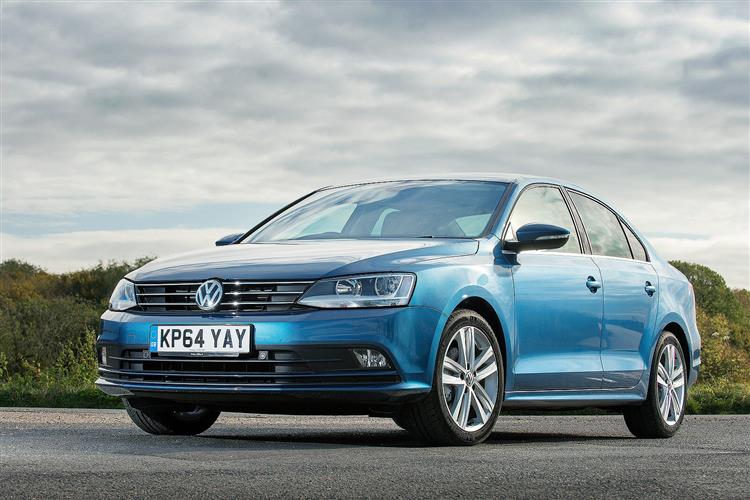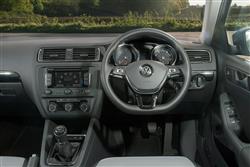This is a sample, showing 30 seconds of each section.
JETTAZONE YOUR PRECONCEPTIONS (some text hidden) SECTIONED_new_volkswagenjetta_2015
By Jonathan Crouch
Introductionword count: 51
Volkswagen's sixth generation Jetta was improved in 2014 to make it smarter and cleverer, offering customers a different alternative to the Golf hatch. With this saloon, you get a huge boot and rear passenger space almost able to rival the larger, pricier Passat. Does it make sense as a used buy?
Modelsword count: 7
4-DOOR SALOON (1.4 / 2.0 TDI DIESEL)
Historyword count: 372
Volkswagen's Jetta. It's a Golf with a boot isn't it? Well yes and no. In more recent years, the Wolfsburg brand has sought to give this car more of its own identity, a trend that continued with the updated version of the sixth generation model that the brand announced in 2014. The Jetta has always sold to people who couldn't quite stretch to either Volkswagen's larger Passat saloon or a BMW 3 Series or Audi A4-sized compact executive sedan. And it has always been a relatively rare sight on our roads: most buyers here in search of a car of this size would rather have the hatchback versatility of a Golf. American and Mediterranean customers see things differently though and these markets have combined to make this one of the world's most popular saloon models, with over 14 million units sold since the very first Jetta was launched back in 1979. The US in particular has been a happy hunting ground for Volkswagen, this car having long been the brand's most popular Stateside model. American buyers still snap up over 110,000 Jettas every year, with college kids attracted by endorsement from singers like Katy Perry and cheap pricing made possible by the close proximity of this car's Mexican assembly plant. In order to sell the same design for nearly twice as much money in Europe, Volkswagen plushed up those cars heading across the Atlantic and added in the Golf's more sophisticated multi-link rear suspension, plus electric power steering, a better quality cabin and subtle styling changes. This would have been a clever and very profitable strategy if it had worked, but sales of the early version of this sixth generation model were slow from its original launch here in 2011. Hence the need for the significantly revised version we're going to look at here, launched in 2014 with smarter looks, an upgraded cabin, extra safety features and revised engine range. Volkswagen hoped all of this would be enough to get this Jetta's core values noticed: its refinement, its long distance comfort and the fact that nothing in the class can offer anything like as much luggage space. It wasn't and the car was quietly withdrawn from sale at the end of 2017.
What You Getword count: 1123
The original version of this sixth generation model had a key objective to meet right from the outset. From the start, stylist Klaus Bischoff and the design team were determined that it should be more than just a Golf with a boot. That's why the MK6 version of this four-door model was styled to be over 400mm longer than its hatchback counterpart, its 4.6m total length actually bringing it to within around 100mm of a Passat saloon from the next class up. It's also why this car shares not a single panel with its hatchback stablemate. Less welcome perhaps, is the news that this Jetta doesn't share any Golf underpinnings either. The Volkswagen Group's modern-era MQB platform didn't make it into the MK6 Jetta, so this saloon remained designed around the same elderly Golf MK5 platform that it was based on in its previous fifth generation form. To try and compensate, Volkswagen gave this revised sixth generation version a light visual refresh that aimed to give a bit more purpose to this design's clean, cohesive but not especially memorable look. It was all pretty subtle though. At the front, there was a revised radiator grille with three horizontal fins, plus a reprofiled bumper, LED daytime running lights and revised air intakes. In profile, you might even mistake this car for a Passat. Viewed from the side, this sixth generation design's extra length is more obvious, emphasised by a sharp, so-called 'Tornado line' that cuts through the large side surfaces in an attempt to offer a strong dynamic appearance. The smarter wheels also supply a touch of up-market class. At the back, revisions to the post-2014 version of this car included sleeker tail lights and a revised bumper. As before, thanks to the long overhang, the same very large boot remained. It was always one of this car's biggest selling points, as you realise upon flipping the trunk lid, something you can do with just a press of a button on the keyfob. The 510-litre area revealed is massive, around 30% or (to be more specific) 130-litres more than you'd get in a Golf from this era. The theoretically much bigger Volkswagen Passat saloon we mentioned has a trunk that in this era was only 76-litres larger than this. Compact saloon rivals from other brands that are similarly sized to this Jetta can offer nothing like as much boot space. In this era, an Audi A3 saloon delivered 425-litres, a Mazda3 Fastback managed only 419-litres and a Volvo S60 just 380-litres. If you need more room in this Volkswagen, you can push forward the rear bench - though that'll only be possible in a split-folding fashion if you've avoided entry-level trim. Most models get a ski hatch for longer items, but whatever Jetta you're trying, once the backrest is flattened, there's enough capacity for all kinds of unlikely loads to be carried. So, your luggage will have more space to move around than it would in a Golf. And your rear seat passengers will enjoy the same benefits. This car has a substantially longer wheelbase than its hatchback counterpart, something you especially notice in the back where there's ample headspace - and more legroom for rear seat passengers than you'd expect a compact saloon to be able to provide. Two burly adults who wouldn't really relish a lengthy trip in the back of a Golf will be significantly better served here, with pretty much the same kind of space that a larger Mondeo or Passat-class car used to offer until just a few years ago. The provision of rear airvents is also quite unusual in this class of car. And up-front? Well, it's a Volkswagen isn't it, so as ever, the overall look and feel speaks of quality. With cabin detail and fit and finish though, we come to another area where you might wish that this car did have a little more in common with a Golf. Build quality from the Jetta's Mexican factory wasn't quite up to German standards: nor was the cabin design. To be fair, the differences aren't overt: it's just subtle stuff, some elements more significant than others. On a Golf for example, you'd get nicely padded door trims. Here, the door cards are fabricated from hard plastic right up to window level. Some tinier Golf details are missing too - the way, for example, that on that car, the instrument dial glasses are neatly angled towards each other. You also have to take into account that the Jetta is an older design - so for example, it doesn't get the kind of large, sophisticated central dash infotainment screen you'd find on modern versions of Volkswagen's evergreen family hatch. Instead, a smaller, more restricted display must suffice. Move from Golf to Jetta ownership and it's things like these that you'd notice. But then hardly anyone does move from Golf to Jetta ownership: the two cars have, after all, always appealed to quite different buyers. Those who do prefer the four-door bodystyle will probably be quite satisfied with what's on offer here. As you'd expect in this day and age, there are soft-touch plastics and chrome-rimmed dials, along with some quite tasteful 'Zebrano' wood-effect trim on plusher versions. And Volkswagen updated the cabin atmosphere of this revised model by smartening the trim around the centre console, introducing more up-market fabric designs for the seats and door trims and adding slick ambient lighting. This is the sort of stuff the Wolfsburg brand thought European buyers would insist upon but never bothered to add to the budget-orientated American version of this car. That's one reason why US Jetta models were always so much cheaper than European-spec ones. Perhaps of most importance though, is the news that no other competitor offers a more comfortable driving position thanks to reach and height adjustment for the redesigned three-spoke steering wheel and (on most models) height adjustment for the driver's seat. The bottom line here is that there are plusher-feeling rivals, but none that you'd rather live with over a four or five-hour journey. Volkswagen has thought through the practicalities too, so there are deep doorbins and you get twin cupholders behind the gearlever, though the rear one can sometimes get blocked by the sliding armrest on top of the central storage bin. Talking of drinks, the decently-sized glovebox gets an air conditioning feed that will cool them - a real boon in hot weather. The technological attention to detail's nice too - let us give you an example. Select reverse or operate the windscreen washers and the air conditioning system automatically switches itself to recirculating air mode so as to prevent smells - from exhaust fumes or windscreen wash - from entering the car. Nice.
To see the full road test text contact us on 0330 0020 227
Pictures (high res disabled)

.jpg)
|
.jpg)
|
.jpg)
| |||
.jpg)
|
.jpg)
|
.jpg)
| |||
.jpg)
|
.jpg)
|
.jpg)
| |||

|
Scoring (subset of scores)
Category: Compact Family Cars
| Performance | |
| Handling | |
| Comfort | |
| Space | |
| Styling, Build, Value, Equipment, Depreciation, Handling, Insurance and Total scores are available with our full data feed. | |



